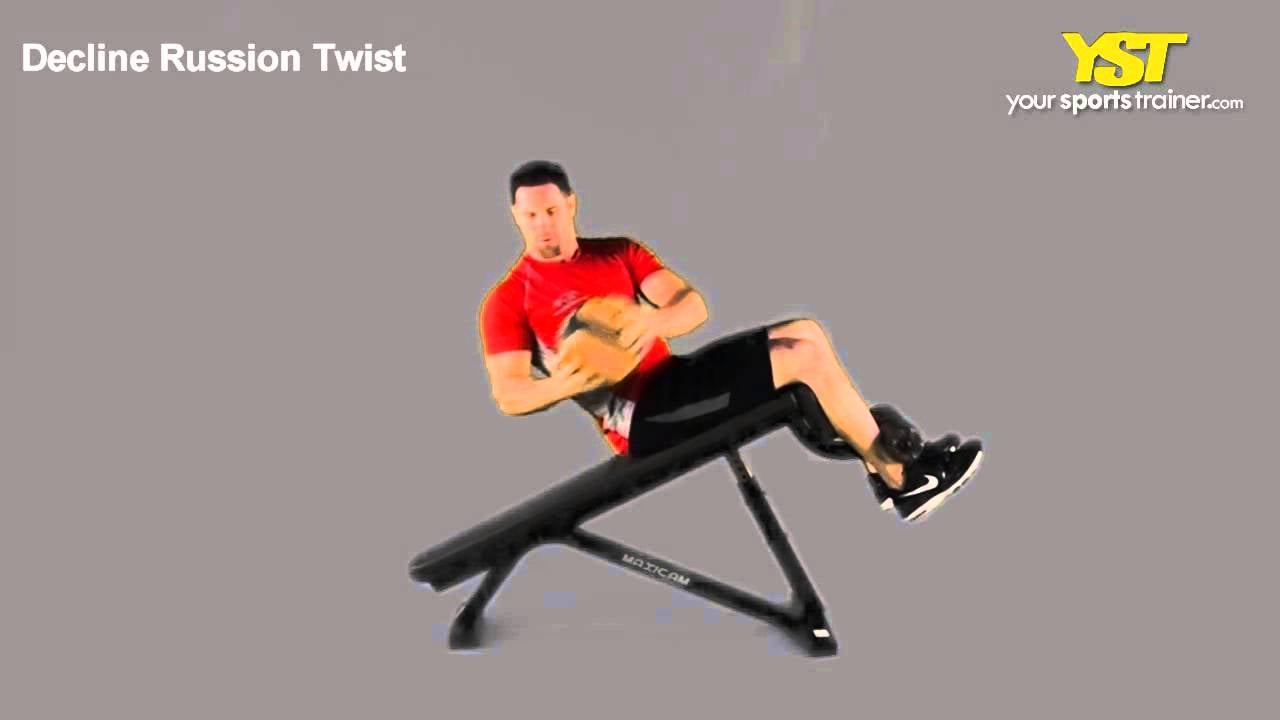A portable abs bench is a great way to strengthen and tone your abs without spending much money on expensive gym equipment.
They come in simple foldable designs, larger stationary models (often with rollers/handles), and advanced adjustable versions.
They all help train all the major abdominal muscles, including the rectus abdominis, obliques, and transverse abdominis.
Trust me: you can develop that coveted six-pack definition right at home with these exercises and consistent effort. I’ll share all my best tips for proper form and technique to keep you safe and maximize your results.
Let Begin!
BODY FAT % CALCULATOR: KNOW YOUR BODY FAT PERCENTAGE TO GET VISIBLE ABS
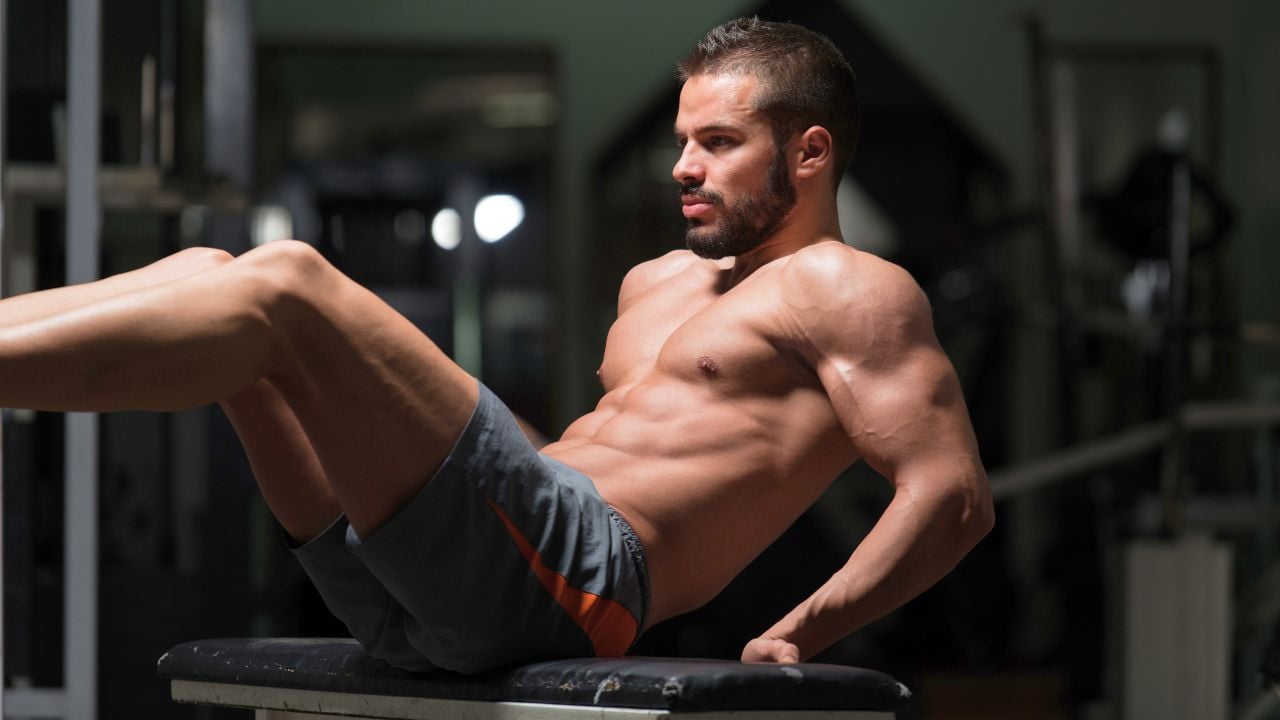
- Basic Abs Bench Exercises for Beginners
- 1. Lying Leg Raises
- 2. Bench Sit-Ups
- 3. Seated In And Outs
- 4. Incline Reverse Crunch
- 5. Decline Crunch
- 6. Incline Side Plank
- Advanced Abs Bench Exercises
- 7. Bench Russian Twist
- 8. Bench Oblique Crunch
- 9. Twisting Sit-Up
- 10. Copenhagen Plank
- 11. Incline Hip Raise
- 12. Dragon Flag
- Conclusion
Basic Abs Bench Exercises for Beginners
Before attempting more difficult variations, master these abs bench basics.
Let’s review the basic exercises that every abs bench beginner should learn.
1. Lying Leg Raises
Lying leg raises are touted as killer abs exercises, but your hip flexors actually reap some major benefits. So don’t be surprised if your hips feel a bit of a burn during this one.
It mainly works on the lower part of your abs, making it stronger and more toned.
It also strengthens the muscles of the upper thigh and the quadriceps without stressing the knee joint.
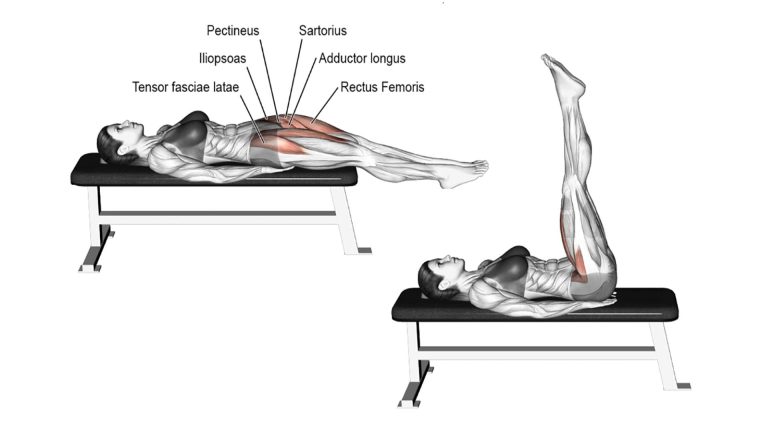
How To Do
- Lie down on an ab bench or on the floor with your legs extended.
- Place your hands underneath your lower back and glutes to provide support.
- Keep your legs straight and together, and engage your core muscles. Lift your legs until they are parallel to the floor.
- Pause at the top of the movement for a second.
- Slowly lower your legs back down to the starting position. Keep in mind: Don’t just swing your legs up and down.
- Do this movement 15 to 20 times for three to four sets.
- You could add weight to your feet to make the exercise more challenging.
2. Bench Sit-Ups
Todingan et al. (2016) reported significant waist circumference reductions after 15 days of sit-ups at different angles.
It helps to strengthen for you working your core, including your abs, obliques and lower back gluteal muscles.
One reason the sit-up has received negative attention is that many people are doing it in poor form.
When done slowly and carefully, sit-ups will not cause back pain but help build strength and improve posture over time.
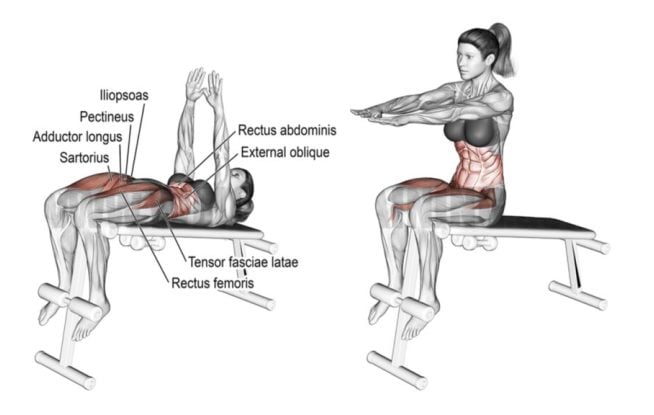
How To Do
- Hook your feet under the pad and sit on the decline bench with your torso upright, with your feet under the pad.
- You can place your hands behind your head or in front of you.
- Lift your shoulders and upper back off the decline bench by contracting through your abdominal muscles.
- Don’t let your shoulders roll forward. Keep your chest up and shoulders back.
- Hold this position for a second and then slowly return to the starting position.
- Do the negative part of the exercise as slowly and carefully as the positive part.
Know More: 100+ Best Ways To Lose Weight To Build Six Pack Abs
3. Seated In And Outs
This dynamic movement is excellent for targeting the lower portion of the rectus abdominis and heavily engages the hip flexors.
For the most effective execution, keep the trunk stable and bring the knees as close to the chest as possible. This makes the abdominal muscles work harder.
How To Do
- Sit on the edge or end of a flat bench. Place your hands on the bench behind you or grip the sides for support.
- Lean your torso back slightly (around 45 degrees or less – find a challenging but controllable angle).
- Extend your legs straight out in front of you.
- Then, bend your knees and pull them towards your chest while bringing your torso slightly forward into a crunching motion.
- Pause for a moment and then lower your legs back down until your heels almost touch the ground.
4. Incline Reverse Crunch
The incline reverse crunch is similar to the traditional reverse crunch, except that it is performed on an incline bench instead of a regular bench.
This exercise strengthens the lower rectus abdominis, hip flexors, and obliques.
Since it requires you to work against gravity, it puts more tension on the lower abs and is more difficult than the standard version.
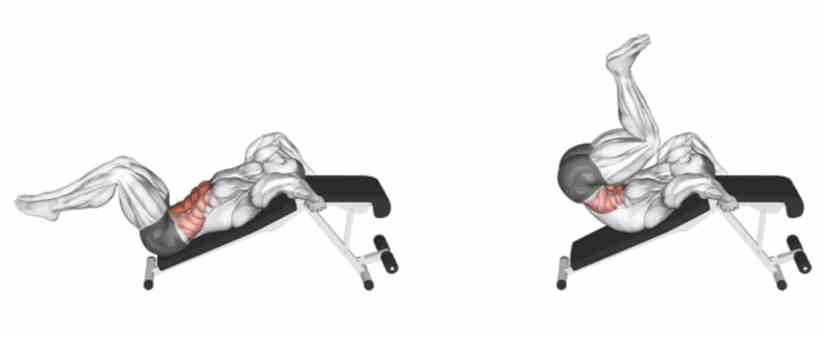
How To Do
- Lie face-up on an incline bench with your head positioned at the higher end.
- Grip the sides of the bench or dedicated handles above/behind your head firmly for stability.
- Bend your hips and knees to 90-degree angles for the start position of the reverse crunch.
- Maintain the bend in your knees and hips, and flex your spine from the bottom to lift your hips up off the bench and curl your knees toward your head.
- Slowly reverse the motion to return your legs to the start position.
- To add more resistance, raise the bench and increase the incline by raising the bench.
5. Decline Crunch
The decline crunch is an advanced abdominal exercise performed on a decline bench. In this exercise, the upper body is positioned lower than the legs.
It is similar to the floor crunch, except with a greater range of motion. It is one of the most effective ab exercises for specifically training the upper abs.
How To Do
- Secure your legs/feet firmly under the pads at the higher end of the decline bench.
- Place your hands lightly behind your head (without pulling on your neck) or cross over your chest (you can also use weight to make it more advanced).
- Curl up as high as possible to get your shoulders and upper back off the bench. Keep the movement slow and under control.
- Hold this position briefly before slowly lowering back to the starting position.
6. Incline Side Plank
The incline side plank is perfect for beginners looking to build core stability.
As the surface becomes more inclined, it will be easier to plank.
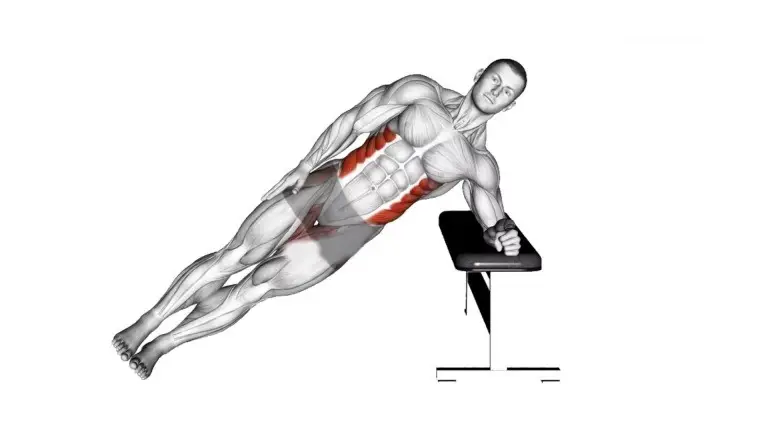
How To Do
- lace yourself sideways next to an incline bench set at a moderate angle. (Higher incline is easier, lower is harder.
- Place your forearm (or hand, for a straight-arm version) firmly on the bench surface directly below your shoulder.
- Extend your legs so your body forms a straight line from your head to your hips to your feet.
- Your feet can be stacked (harder) or staggered (one slightly in front of the other for better balance).
- Hold this position for a set amount of time.
Advanced Abs Bench Exercises
After you’ve completed the basic abs bench exercises, it’s time to perform more difficult moves to strengthen your core.
Do not rush into these exercises until you have truly mastered proper form on all the beginner variations.
7. Bench Russian Twist
The Bench Russian Twist is an advanced rotational exercise that targets the obliques. It helps burn fat and define the hard-to-target obliques while improving your midsection rotation capabilities.
How To Do
- Sit on the edge of a bench and hold a weight in both hands in front of your chest.
- Lean back slightly to engage your core.
- Twist your torso to the right, bringing the weight towards the right side of your body.
- Rotate back to the center and then to the left side.
- Keep your back straight and avoid rounding your shoulders to prevent back strain.
- Continue alternating sides for the desired number of repetitions.
Know More: 21 Best Oblique Exercises For A Strong Core
8. Bench Oblique Crunch
Oblique crunches with your feet on a bench are harder than regular floor crunches because you raise your feet up, which makes the workout harder. This variation focuses more on the oblique muscles.
How To Do
- Place your lower legs and feet on the bench with your knees bent at a 90-degree angle.
- Your back should be flat on the ground, and your hands should be placed lightly behind your head or beside your ears to support your neck.
- Curl up and rotate your torso towards one side. Aim to bring your rib cage towards your hip on the same side.
- Pause at the top of the movement. Then, slowly lower back down to the starting position.
- Perform the desired number of repetitions on one side before switching to the other side.
9. Twisting Sit-Up
A decline sit-up bench positions your upper body at an angle so that it’s lower than your hips and thighs. It is a challenging exercise for developing the upper abs.
This position forces your body to work harder, as you have to work against gravity and through a wider range of motion.
It’s a great exercise for intermediate to advanced lifters because it is moderately challenging but very effective for its intended purpose.
How To Do
- Sit on the decline bench, hook your feet under the pad, lean back, and position your hands behind your head.
- As you sit up, twist your torso, directing your right elbow toward your left knee.
- Reverse the motion and lower your torso to the starting position; during the next repetition, direct your left elbow toward your right knee.
- Keep repeating and alternating the side to which you twist your waist.
10. Copenhagen Plank
The Copenhagen Plank (or Copenhagen Adduction Exercise) is a challenging isometric hold that uniquely targets the adductor muscles (inner thighs) of the top leg while intensely engaging the obliques, transverse abdominis, and hip stabilizers on the supporting (bottom) side.
How To Do
- Get in a plank position with your forearm on the floor.
- Place the top foot onto a chair, bench, or another stable surface, while holding the bottom leg off the ground.
- Maintain a straight line from your shoulder to your ankle. Hold for 20–30 seconds.
- Slowly lower back to the starting position.
- Repeat on your other side.
11. Incline Hip Raise
Leg raises are among the most popular abs exercises for men. These moves are very similar to sit-ups, but in this case, the abdominal muscles lift the lower body and pull it forward to the upper body and not the opposite.
It works the rectus abdominis (six-pack muscles) and the oblique (side abs). However, due to the nature of the exercise, hip and leg muscles are also engaged, particularly at the beginning of the movement.
If you have an adjustable sit-up bench, changing the board’s angle can make the move harder or easier.
How To Do
- Lie supine (on your back) on an inclined bench with your legs together.
- Place your hands beside your head and grip the bench for support.
- Support your back by pressing your lower back against the bench.
- Exhale as you slowly raise your legs and curl your hips off the bench.
- Try to hold the contracted position, with your legs in the air.
- Inhale as you slowly lower your hips and legs to the starting position.
12. Dragon Flag
Dragon Flag, also known as the Dragon Fly, is an advanced core exercise primarily targeting the rectus abdominis, transverse abdominis, and obliques.
It also engages other muscle groups, such as the erector spinae, gluteal complex, hip flexors, adductors, latissimus dorsi, and more.
Bruce Lee, a martial artist and actor, popularized this exercise. This exercise works a lot on your core muscles and requires a lot of strength, control, and technique.
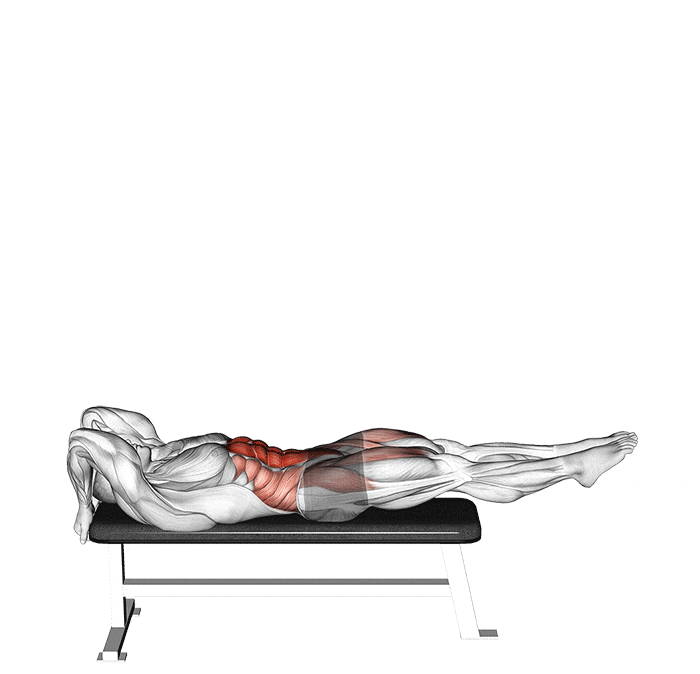
How To Do
- Lie on a bench and grasp the edges of the bench above your head for support.
- Engage your core and lift your legs and hips up towards the ceiling.
- Try to make a straight line from your shoulders to your feet.
- Hold for a while and then slowly lower your body back down without bending at the hips or waist. Your body should move as one solid unit.
- Try hovering just above the bench without touching it, and then raising your body back up to the starting position again.
- If you can’t lift back up, you can lower yourself all the way down to the bench before resetting for the next rep.
To Stay Motivated: 150+ Gym Workout Motivational Quotes To Stay Fit
Conclusion
Abs bench exercises are a great way to strengthen and tone your abdominal muscles. They are versatile and can target all of the major core muscles.
Start out slow with basic crunches and work your way up to more dynamic exercises like the Russian Twist and Dragon Fly.
Mix up your ab routines regularly to conquer plateaus. Smart programming and dedication can transform your midsection with an abs bench.
For more workout tips and creative ab exercises, be sure to check back in with our fitness blog.
What abs bench exercises do you love? Let us know in the comments.
References
- McGill S, Andersen J, Cannon J. Muscle activity and spine load during anterior chain whole body linkage exercises: the body saw, hanging leg raise and walkout from a push-up. J Sports Sci. 2014;33(4):419-26. doi:10.1080/02640414.2014.946437.
- Phys Ther. 2000 Jun;80(6):564-9. Abdominal muscle response during curl-ups on both stable and labile surfaces. Vera-Garcia FJ1, Grenier SG, McGill SM.
- Vispute SS, Smith JD, LeCheminant JD, Hurley KS. The effect of abdominal exercise on abdominal fat. J Strength Cond Res. 2011 Sep;25(9):2559-64. doi: 10.1519/JSC.0b013e3181fb4a46. PMID: 21804427

Manish is a NASM-certified fitness and nutrition coach with over 10 years of experience in weight lifting and fat loss fitness coaching. He specializes in gym-based training and has a lot of knowledge about exercise, lifting technique, biomechanics, and more.
Through “Fit Life Regime,” he generously shares the insights he’s gained over a decade in the field. His goal is to equip others with the knowledge to start their own fitness journey.


